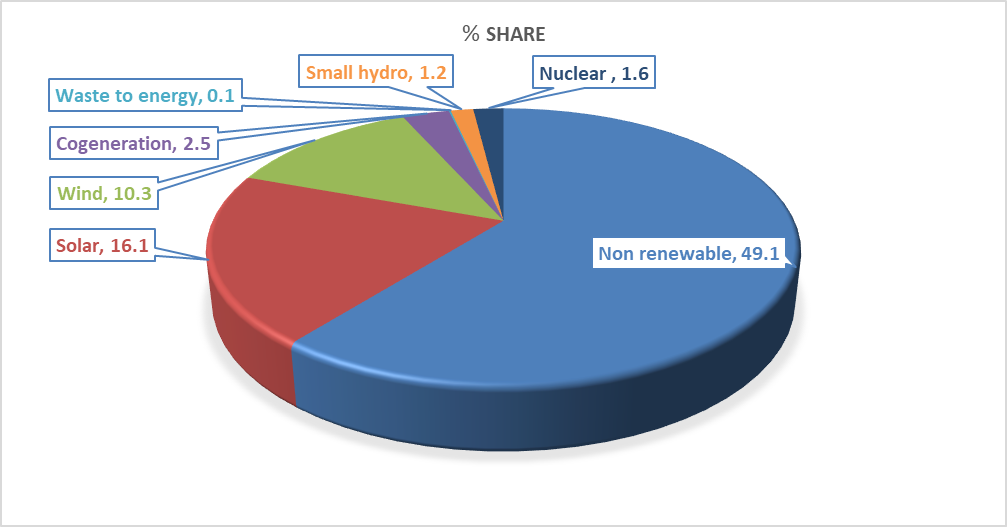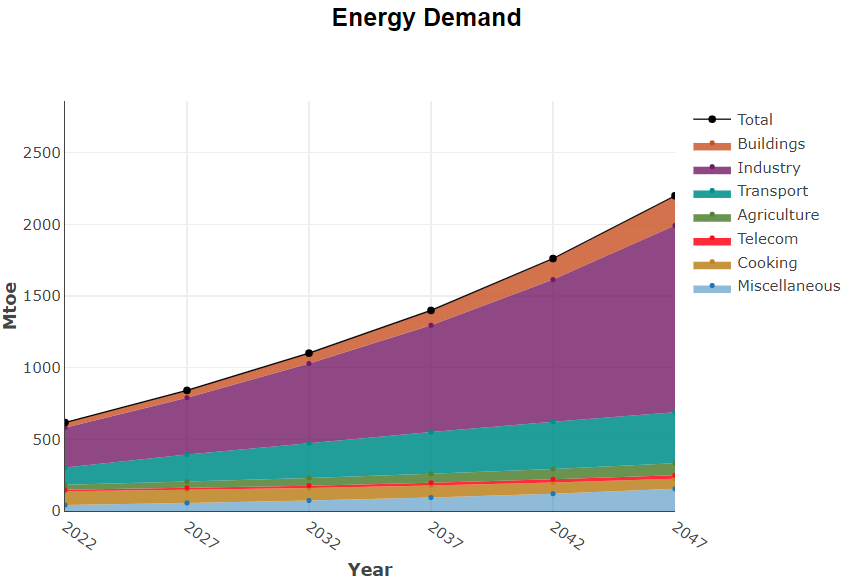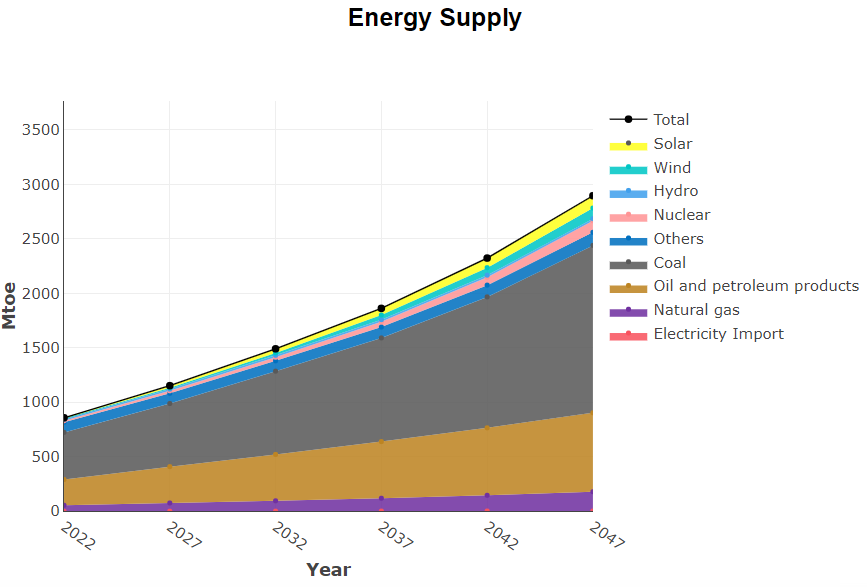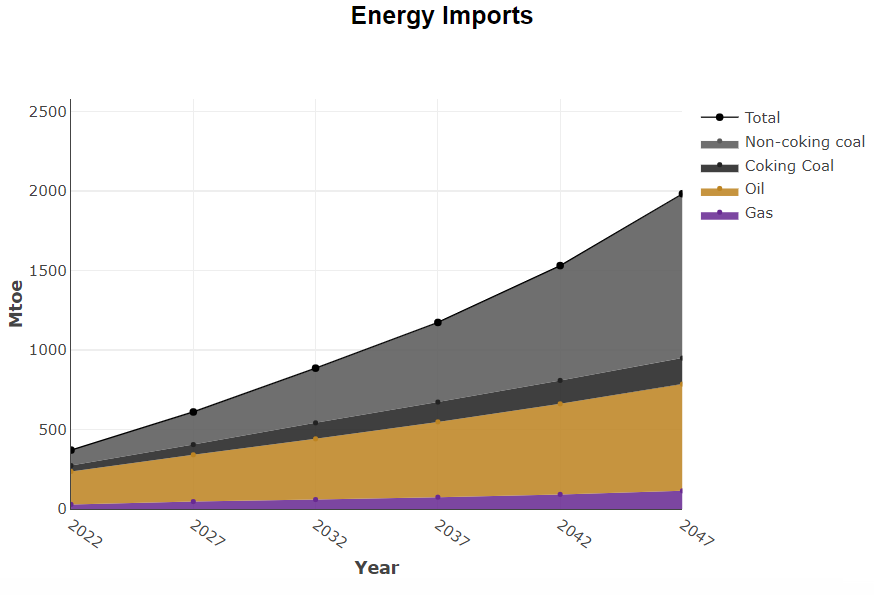India’s Energy Security
2023 AUG 1
Mains >
Science and Technology > Energy > Basics of energy
IN NEWS:
- A Revamped India Energy Security Scenarios (IESS) 2047 (IESS 2047 V3.0) to assess the integrated impact of various green energy policies of Government of India was released by NITI Aayog today.
ABOUT IESS 2047 V3.0:
- IESS 2047 is an open-source, user-friendly interactive tool that can help ministries/ departments to develop a variety of energy transition scenarios to achieve net-zero.
- The tool is flexible enough to provide many permutations and combinations of net-zero pathways. It provides capabilities to compute the energy needs and estimates of the country and hence reduce India’s dependency on external agencies for the estimates.
- Assessing the demand and supply of energy in the country, the tool helps in analysing emissions, cost, land, and water requirements till 2047.
- IESS incorporates several policies related to alternative energy resources like Green Hydrogen, Energy Storage, Renewable Purchase Obligations, PM-KUSUM, offshore wind strategy, Electric Vehicle policy, Energy efficiency, etc.
- Designed with the help of IIT Bombay, the revamped IESS 2047 will be updated on yearly basis. The baseline has been standardised at 2020.
- The web version of the tool offers user-friendly graphical representations of energy demand and supply scenarios for the country based on user choices.
ENERGY SECURITY:
- The International Energy Agency (IEA) defines energy security as the uninterrupted availability of energy sources at an affordable price.

INDIA’S ENERGY SECTOR:
Present status:
- Today, India is the world's third largest producer of renewable energy, with 40% of its installed electricity capacity coming from non-fossil fuel sources.
- As on 31.05.2023, of the total installed capacity of 417 GW, non-fossil fuels account for 179 GW.
- As per the IEA’s World Energy Outlook, India is likely to see the world's biggest rise in energy demand this decade, with demand climbing 3% annually.

Projections:
- As per the IESS 2047 V3.0, India’s energy demand is expected to reach approximately 2200 Mtoe and energy supply to reach 2900 Mtoe by 2047.


- IESS 2047 V3.0 predicts India’s import dependency to rise in the coming years. It expects the total imports to reach roughly 2000 Mtoe by 2047.

CHALLENGES TO INDIA’S ENERGY SECURITY:
- Growing energy needs:
- Energy demand may climb 3% annually due to urbanisation and industrialisation, which will put severe stress on the energy sector.
- High Import dependency:
- India's import of major energy sources - crude oil, natural gas and coal - was 41% of its energy consumption in 2021-22. This results in high current account deficit (CAD), which make the economy vulnerable.
- India also relies heavily on imports to support its clean energy transition efforts. For instance, over 80 % of solar cells and modules are imported from China.
- Tensions in international relations:
- Russia-Ukraine conflict, high inflation in developed countries, de-dollarisation trends etc. continues to create volatilities in the global energy market.
- India’s plans to acquire S400 system from Russia may attract sanctions from the USA, which can affect the import of energy.
- Environment vs developmental concerns:
- Given India’s development state and its efforts to lift large shares of its population out of poverty, the country needs to add more to its energy capacity, which poses a challenge to reducing reliance on fossil fuels.
- Growth of E-mobility:
- The Centre is pushing for mass e-mobility through initiatives like FAME-II and Make in India. To attain this goal, energy needs to be affordable and accessible.
- Depleting energy reserves:
- India lacks sufficient petroleum reserves and its coal reserves are poised to be depleted by the end of this century.
- Question over coal:
- Reaching the goal of net-zero greenhouse gas emissions by 2070 for India would mean an overhaul of a coal-reliant energy sector.
- Infrastructural challenges:
- Transmission losses currently account for around 22% of the total power generated in India.
- Many transmission projects have faced delays because of the difficulty to acquire land and get timely clearances from all stakeholders.
- Ailing DISCOMs:
- The electricity distribution companies (DISCOMs) are facing severe financial losses due to inadequate tariff and high aggregate technical and commercial losses.
- Institutional hurdles:
- Approval of projects, unpredictable tax regime, complicated power purchase agreements etc. affect the accessibility and affordability of energy in India.
- Eg: India has multiple prices for domestic and imported gas, which affects the price of natural gas.
GOVERNMENT EFFORTS:
- Hydrocarbon Exploration and Licensing Policy (HELP):
- HELP aims to minimize the government's discretion in decision-making, eliminate conflicts, reduce administrative delays, and promote the notion of revenue sharing and marketing freedom.
- Various missions:
- National Hydrogen Mission, National Solar Mission, National offshore wind energy policy, National Biofuel Policy etc.
- Pradhan Mantri Ujjwala Yojana for providing clean cooking gas connections to the underserved in the country.
- Ujjwal Discom Assurance Yojana (UDAY) to aid operational and financial turnaround of Power Distribution Companies (DISCOMs) owned by any state.
- Green energy corridor project:
- The project aims at synchronizing electricity produced from renewable sources with conventional power stations in the grid, leading to an integrated grid across the nation.
- Pradhan Mantri Jaiv Indhan-Vatavaran Anukool fasal awashesh Nivaran (PM Ji-VAN) yojana:
- The scheme focuses to incentivise 2G Ethanol sector and support the industry by creating a suitable ecosystem for setting up commercial projects and increasing Research & Development in this area.
- Kisan Urja Suraksha evam Utthaan Mahabhiyan (KUSUM):
- It aims at boosting farmers’ income by allowing them to sell additional power to the grid through solar plants.
- Government will incentivize farmers to run solar farm water pumps and use barren land for generating power for extra income.
- GOBAR-Dhan yojana:
- GOBAR (Galvanizing Organic Bio-Agro Resources) - DHAN scheme aims to impact village cleanliness and generate wealth and energy from cattle and organic waste.
- The scheme also aims at creating new rural livelihood opportunities and enhancing income for farmers and other rural people.
- Integrated Power Development Scheme (IPDS):
- The Ministry of Power, has launched Integrated Power Development Scheme (IPDS) for strengthening of Distribution Infrastructure for the Urban areas having population of more than 5,0000 as per census 2011
- Deen Dayal Upadhyaya Gram Jyoti Yojana (DDUGJY):
- Deen Dayal Upadhyaya Gram Jyoti Yojana (DDUGJY) is designed to provide continuous power supply to the entire rural India. The scheme was launched in November 2014.
- One Nation One Gas Grid:
- Petroleum and Natural Gas Regulatory Board (PNGRB) has authorized approximately 33,500 km natural gas pipeline network across the country with the aim to create a national gas grid and increase the availability of natural gas across the country.
- City Gas Distribution (CGD) networks to provide Piped Natural Gas (PNG) to households, industrial uses and Compressed Natural Gas (CNG) for transportation uses.
- Projects such as Urja Ganga project and Indradhanush Gas Grid Ltd
- International Solar Alliance:
- The ISA is an alliance of more than 120 countries to collectively work for efficient exploitation of solar energy to reduce dependence on fossil-based fuels.
WAY FORWARD:
- Participation of all stakeholders:
- The Indian power sector is listed as a concurrent subject in the Constitution of India, where both centre and states have control. Therefore, success of power sector policy and execution has to have a buy-in of both the stakeholders.
- Utilise renewable energy potential:
- India is blessed to have a huge potential in renewable energy resources and the country should exploit this to the maximum extent so as to meet its on-going energy deficit issues and reduce its dependence on other countries.
- Promote energy efficiency practices:
- While improving supply, India needs to focus equally on promoting energy efficiency practices. This can include measures such as smart metering, efficiency rating for appliances, mandating green building codes etc.
- Storage technology:
- Efficient energy storage facilities are vital for a reliable system. Hence, research should be encouraged in the development indigenous storage facilities.
- Stable policy support:
- The industry should be consulted while formulating rules, regulations and taxes related to the energy sector.
PRACTICE QUESTION:
Q. Energy security is significant for socio-economic development. Discuss. What efforts have the government taken to ensure it.




